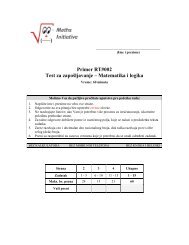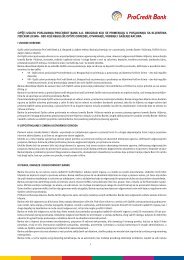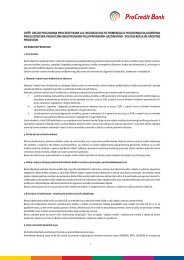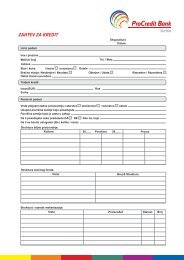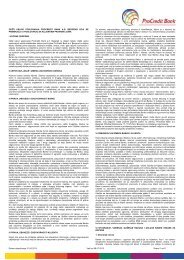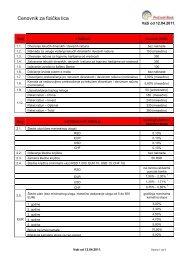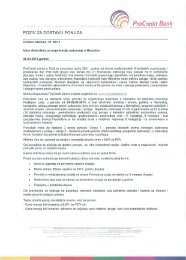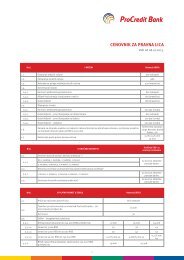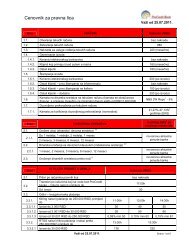Annual Report 2010 - ProCredit Bank
Annual Report 2010 - ProCredit Bank
Annual Report 2010 - ProCredit Bank
- No tags were found...
You also want an ePaper? Increase the reach of your titles
YUMPU automatically turns print PDFs into web optimized ePapers that Google loves.
Management Business Review 11<br />
Political and Economic Environment<br />
In <strong>2010</strong> Serbia continued to make progress towards<br />
EU accession. EU officials recognised<br />
that the country had implemented significant reforms,<br />
that its co-operation with the International<br />
Criminal Tribunal for the former Yugoslavia in The<br />
Hague had improved, and that it was a factor for<br />
stability in the region. In November, the European<br />
Commission issued its Serbia <strong>2010</strong> Progress<br />
<strong>Report</strong>, confirming that the country had made<br />
political progress, and was on the road to economic<br />
recovery and GDP growth. However, it also<br />
mentioned that issues relating to the judiciary<br />
and to corruption still needed to be addressed.<br />
By December the Stabilisation and Association<br />
Agreement between the EU and Serbia had been<br />
ratified by 11 of the EU’s 27 member countries.<br />
The real economy showed signs of improvement.<br />
After a 3.1% decline in 2009, 1 GDP grew<br />
1.7% 2 y-o-y, and this upward trend is expected<br />
to continue. Increased industrial output and rising<br />
exports aided by a competitive exchange rate<br />
helped to narrow the trade deficit, but it is still<br />
large and capital inflows are insufficient.<br />
In the first six months, inflation was consistently<br />
below the NBS’s target tolerance band of 6 ± 2%,<br />
but started to rise in the second half of the year,<br />
overshooting the tolerance band in October. 3 In<br />
response, the National <strong>Bank</strong> raised key interest<br />
rates and signalled a tightening of monetary policy.<br />
Price increases were due partly to food price<br />
shocks and partly to the depreciation of the local<br />
currency by approximately 11%. The value of<br />
the dinar against the euro dropped from a peak<br />
of RSD 95.9 in January to a low of RSD 107.5<br />
in November. 4<br />
Fiscal performance remained on target. In November<br />
the Serbian parliament adopted a revised<br />
budget for <strong>2010</strong> with a deficit of RSD 148 billion<br />
(4.9% GDP), and the target for 2011 is a budget<br />
deficit of no more than 4.1% of GDP. 5<br />
Fitch Ratings revised Serbia’s outlook from negative<br />
to stable and reaffirmed the country’s longterm<br />
Issuer Default Rating of BB- for foreign currency<br />
debt. The government’s commitment to<br />
comply with the IMF programme and the narrowing<br />
of the current account deficit were key factors<br />
behind the revision of Serbia’s outlook.<br />
IMF support for the balance of payments under<br />
a EUR 1.87 billion stand-by arrangement which<br />
runs until April 2011 has helped bolster reserves<br />
and investor confidence, while foreign-owned<br />
banks have maintained their exposure to Serbia. 6<br />
Financial Sector Development 7<br />
The banking sector in Serbia comprised 33 banks<br />
and 8 representative offices of foreign banks at<br />
the end of <strong>2010</strong>. Two government-owned banks<br />
merged in September. Compared to 2009, total<br />
banking assets decreased to 1.56% in real<br />
terms to RSD 2,534 billion (EUR 24 billion). As<br />
in previous years, the top three banks accounted<br />
for approximately one third of total banking<br />
sector assets.<br />
Lending was the main driver behind asset growth,<br />
continuing the trend of recovery that started in the<br />
last quarter of 2009. Total net lending amounted<br />
to RSD 1,685 billion (EUR 15.97 billion), an increase<br />
of RSD 285 billion (EUR 1.37 billion) or<br />
9.38% compared to the end of 2009. Business<br />
loans again made up the largest share of bank<br />
lending, amounting to RSD 936 billion (EUR 8.87<br />
billion) or 56% of the total, while loans to private<br />
households came to RSD 501 billion (EUR 4.75<br />
billion) and loans to the public sector totalled RSD<br />
209 billion (EUR 1.98 billion). Although foreign<br />
1<br />
National <strong>Bank</strong> of Serbia, Key macroeconomic indicators,<br />
www.nbs.rs/export/internet/english/80/index.html<br />
2<br />
National <strong>Bank</strong> of Serbia, http://www.nbs.rs/export/<br />
internet/english/15/konferencije_guvernera/<br />
attachment/20110315_DS_press_presentation.pdf<br />
3<br />
National <strong>Bank</strong> of Serbia, Target and actual inflation,<br />
www.nbs.rs/export/internet/english/30/30_9/<br />
kretanje_inflacije.html<br />
4<br />
National <strong>Bank</strong> of Serbia, Exchange rates<br />
5<br />
IMF Country <strong>Report</strong> Jan. 2011, http://www.imf.org/<br />
external/pubs/ft/scr/2011/cr1109.pdf<br />
6<br />
IMF Country <strong>Report</strong> Jan. 2011, http://www.imf.org/<br />
external/pubs/ft/scr/2011/cr1109.pdf<br />
7<br />
Unless otherwise stated, all figures in the Financial<br />
Sector Development section were taken from National<br />
<strong>Bank</strong> of Serbia, <strong>Bank</strong>ing Supervision, Fourth Quarter<br />
<strong>Report</strong> <strong>2010</strong>



